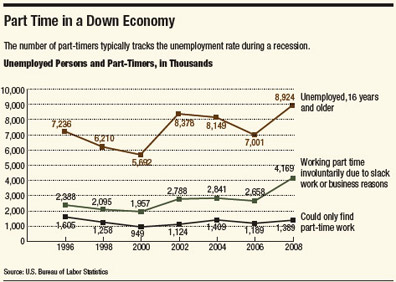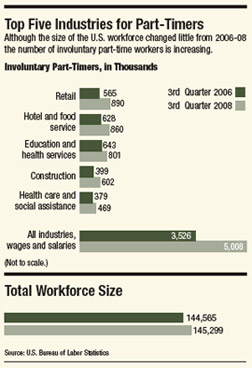Cutting Hours Without Increasing Risk
Compared to layoffs, cutting hours may be better for business and workers. But first, uncover all the hidden risks.
 The mood at Piper Aircraft Inc. was jubilant last May when James Bass, president and chief executive officer, gathered employees at headquarters in the Vero Beach Municipal Airport and announced that a two-year site-selection evaluation was completed.
The mood at Piper Aircraft Inc. was jubilant last May when James Bass, president and chief executive officer, gathered employees at headquarters in the Vero Beach Municipal Airport and announced that a two-year site-selection evaluation was completed.
Flanked by Florida Gov. Charlie Crist and county officials, Bass told his 1,200 workers that a move to a far-flung location such as Albuquerque or Oklahoma City had been ruled out. As part of a three-year, $32 million incentive agreement, Piper would stay in the town where it had been operating for more than 50 years.
“Our decision is not just a vote of confidence for our hometown,” Bass said. “It is also a commitment by Piper to Indian River County and the state of Florida.”
Crist, in turn, praised the manufacturer for pledging several hundred new jobs by 2012 and maintaining a constant staffing level for an additional three years. “Piper Aircraft’s continuing presence will mean thousands of jobs and hundreds of millions of dollars in wages, economic development and other contributions,” he gushed.
These days, spirits at Piper are far less upbeat. Demand for the company’s products has plummeted. The credit squeeze has made it difficult for prospective customers to get financing.

“People aren’t buying planes,” company spokesman Mark Miller replies when asked what prompted a layoff of 150 workers––some 12 percent of Piper’s staff––just seven months after it promised to grow. “You don’t want to build planes just to have them sit on the runway.”
But booting workers isn’t Piper’s only way of dealing with recession. In December, the company scaled back to a four-day workweek, with employees taking a commensurate 20 percent pay hit. Benefits remain unchanged.
Some Hidden Costs of Layoffs Severance. Payouts on accruals of paid time off. Unemployment Benefits Outplacement Services Cost of staffing and training when economy turns around. |
Scaling back hours is a cost-cutting strategy gaining ground with U.S. businesses, and not just in industries such as manufacturing and retailing where workload normally swings by season. In November 2008, 7.3 million individuals were working 35 hours or less per week because of the slack economy––nearly double the number in June 2006, the recent low, according to the U.S. Department of Labor. During the same period, the percentage of total U.S. employment made up of involuntary part-timers increased by 2.4 percentage points, to 5.1 percent of the workforce.
Permanent layoffs are still more common than shifting workers from full- to part-time and are sometimes necessary. But layoffs carry hidden costs that many employers forget to account for, employment experts say. Among them: severance, payouts on accruals of paid time off, unemployment benefits and outplacement services.
Employers who scale back hours don’t necessarily avoid taking a hit in unemployment benefits––many states pay partial unemployment benefits to employees working reduced schedules. In those states, employers that cut hours rather than jobs take a smaller hit on their unemployment insurance risk rating, according to Ben Fendler of the Washington, D.C.-based National Association of State Workforce Agencies, a professional group for state unemployment administrators.
Still, taking into account the cost of staffing up and retraining new workers when the economy turns around, the benefits of keeping workers onboard—albeit on a scaled-back basis—may outweigh the savings that stem from layoffs.
There is also a human element to keeping workers onboard, even with reduced pay. “It spreads the pain,” says Cornelia Gamlem, SPHR, president of GEMS Group Ltd., a human resource consulting firm in Vienna, Va.
There’s little in the law to prevent most employers from switching full-timers to part time, furloughing workers or making other scheduling changes that affect how much pay a worker takes home. But organizations that cut back haphazardly could see costs rise rather than go down, legal experts warn. A bungled employment action may fuel lawsuits from angry employees who believe they have been unfairly targeted.
“For every employer action, there’s an opposite employee reaction,” warns attorney Christine Walters, SPHR, who runs FiveL, an HR consultancy in Westminster, Md.
If your company needs to reduce employee hours to adjust to economic realities, minimize your risk. Here are some effective ways.
Time Management
The Fair Labor Standards Act (FLSA) sets standards for minimum wage and overtime pay. While it covers most workers, several classes of employees qualify for exemptions that free employers from overtime-pay requirements.
The FLSA doesn’t define full- or part-time work. Officials of the U.S. Labor Department enforce the FLSA, and its web site states, “This is a matter generally to be determined by the employer.”
Nonetheless, employers should pay attention to how cutting back hours may jeopardize employees’ FLSA-exempt status, says attorney Tyler Paetkau of employment law firm Littler Mendelson in San Francisco. A cut of only a few hours may bring workers’ pay below the $455 minimum weekly salary required to qualify for FLSA white-collar exemption. Cut more than just a few hours in a single week and even relatively highly paid workers may lose exempt status and, technically, become eligible for overtime pay.
Minimize the risk of violating wage and hour laws by prohibiting exempt employees whose hours have been cut from working during non-work time—even checking e-mail or taking phone calls, advises employment lawyer Stuart Miller of Davis Wright Tremaine LLP in San Francisco. Those who do work off the clock could be eligible for overtime if their wages were cut commensurate with reduced hours, he says, since that effectively makes them hourly workers.
Cutting Bias
Employers must ensure that a cutback doesn’t discriminate against a protected class of employees, including women, older workers, black employees or employees from any other racial or ethnic group––or cause reverse discrimination. Discrimination complaints aren’t just a hypothetical risk; statistics show that they typically increase during an economic downturn.
Organizations are prohibited from intentionally or unintentionally discriminating against a protected group. So, even if an employer finds that it has a legitimate business reason to cut hours in a particular department, it may not be shielded from a discrimination charge if a legally protected individual or group proves it has been negatively affected.
“The beauty of disparate impact for the plaintiff’s attorney is that intent doesn’t matter,” says Paetkau, who typically represents management in discrimination suits.
Employers may reduce exposure by conducting adverse or disparate impact analyses before making changes. And when studies show that any protected group is negatively affected disproportionately, an employer should “reconsider its selection criteria.”
Employers must consider whether a change that affects workers’ pay, including cutting hours, puts them at heightened risk of retaliation claims by workers who previously filed complaints of any kind or sought accommodations, such as family and medical leave. Such claims are now the fastest-growing type of complaint filed with the U.S. Equal Employment Opportunity Commission and second only to race discrimination in terms of cases filed. “A reduced work schedule could easily be construed as retaliation,” says attorney Denise Kay, SPHR, president of the Denver HR consultancy Employment Practices Solutions Inc. When a cutback is challenged, “a nondiscriminatory business justification will need to be provided.”
| Spreading the Pain Human resource professionals can reduce the toll that a cut in hours, or a furlough, takes on employees’ pay by spreading out the cut over a period of time, says attorney Christine Walters, SPHR, who runs FiveL, an HR consultancy in Westminster, Md. That action may soften the blow and reduce the likelihood of lawsuits. For example, an employer may require an exempt, salaried worker earning $50,000 annually to take off one unpaid day per month during a six-month period––effectively cutting 48 hours of pay. Nothing prevents the employer from recalculating the worker’s salary and portioning out the reduction during the six-month period, Walters says. For an employee working a 40-hour week, the difference between the higher salary rate and the lower, furlough rate is about $100 per pay period. In contrast, the full hit of an unpaid day in a single paycheck would be nearly twice that amount. |
Head off a retaliation charge with data that will convince employees—and their attorneys—that cuts are being made objectively and without malice, advises attorney Mary E. Drobka of Davis Wright Tremaine in Seattle. “We all have unlimited capacity to rationalize the reasons why we are selected. The best way to minimize any number of different employment-related claims is to have clear selection criteria.”
 Workers’ Comp
Workers’ Comp
Employers with workers’ compensation cases often get pulled in opposite directions by injured employees and insurers. Reducing the hours of a worker who is back on the job but getting paid less than his pre-injury rate further complicates this relationship, says Margaret Spence, a member of the Society for Human Resource Management’s Employee Health, Safety and Security Special Expertise Panel and president of Douglas Claims & Risk Consultants Inc., a workers’ compensation consultancy in Boca Raton, Fla.
Since reducing workers’ hours may affect eligibility for workers’ compensation benefits, employers should discuss changes that will affect a worker’s pay with their workers' comp insurer before making a change, Spence says. In some cases, reducing the hours of an employee who is on light, limited or restricted duty will create additional financial exposure for the employer. In those instances, the insurer will have to supplement the employee’s lost wages and may recommend that the employer offer the employee a monetary settlement to limit the cost.
Union Matters
Employers in union shops generally are required to bargain over the decision to cut hours and employees affected, even with no labor contract in place or when the contract doesn’t address the issue. An organization that implements any change before reaching agreement or a good-faith impasse with its unions may be found to have acted unlawfully and ordered to provide back pay, says Drobka.
Nonbinding Words
During an economic downturn, employers need to be more vigilant to avoid making loose statements in employment letters or other written documents that may be seen by workers as binding contracts, Paetkau advises. Promising an annual salary in a hiring letter can be dicey if the company later cuts hours. To be safer, describe the salary paid during a single pay period.
“You want to prevent the claim that you’ve kept an employee from earning what you promised,” he says.
Meanwhile, as the recession grinds on in Vero Beach and across the nation, the economy continues to soften demand for products, bite into profits and squeeze budgets. Some employers undoubtedly find that cutting back hours isn’t enough. In February, at press time, Piper laid off 300 workers––in addition to the 150 let go late last year. And it slated two across-the-board, week-long unpaid furloughs for later in the year.
“This is a very difficult and agonizing situation driven by virtually unprecedented and unforeseeable business circumstances,” Miller said in a prepared statement. “Our hearts go out to the people we have had to let go, and we’re focused now on bringing back as many people as possible once the economy recovers.”
The author is senior writer for HR Magazine.
Web Extras
- SHRM video: Cutting Hours Without Increasing Risk
- SHRM article: DOL Opinion Letters: Shutdowns May Have Impact on FLSA-Exempt Status (SHRM Legal Issues)
- SHRM article: Managing a Downturn (HR Magazine)
- SHRM article: Layoff Aftermath (HR Magazine)
- SHRM article: Communication Can Help Motivate During Troubled Times (HR Employee Relations Focus Area)
- SHRM article: Economic Woes Hit Female Workers Particularly Hard (HR News)
- SHRM toolkit: Fair Labor Standards Act
- SHRM toolkit: Overtime
- SHRM book: Weathering Storms: Human Resources in Difficult Times
- Report: Involuntary Part-time on the Rise (Bureau of Labor Statistics)
Advertisement
An organization run by AI is not a futuristic concept. Such technology is already a part of many workplaces and will continue to shape the labor market and HR. Here's how employers and employees can successfully manage generative AI and other AI-powered systems.
Advertisement


